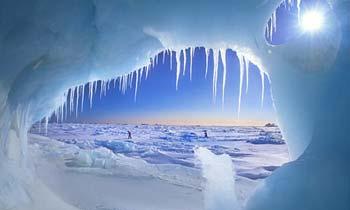Source: Xinhua
04-07-2009 11:34
Special Report: Tech MaxBEIJING, April 7 (Xinhuanet) -- The Arctic is stepping on smaller and thinner ice than ever before,with strong old ice increasingly being replaced by quick-to-melt young ice, said researchers with NASA and the National Snow and Ice Data Center in Colorado.
 |
| The Arctic is stepping on smaller and thinner ice than ever before,with strong old ice increasingly being replaced by quick-to-melt young ice.(File photo) |
According to the researchers, this winter's maximum Arctic sea ice extent was 5.85 million square miles (15million and 150,000 square kilometers) -- about 278,000 square miles (720,000 square kilometers) less than the Arctic average between 1979 and 2000.
In normal winters, ice is often about 10 feet(3 meters )thick or more, but this year, the thick ice cap barely penetrates the bull's-eye of the Arctic Circle.
"We're not set up well for summertime," ice data center scientist Walt Meier said, "We're in a very precarious situation."
The amount of thick sea ice hit a record wintertime low of just 378,000 square miles this year, down 43 percent from last year, Meier said.
Usually, younger, thin ice accounts for about 70 percent of the ice cover. This year it reaches 90 percent, Meier added.
Sea ice is important because it reflects sunlight away from Earth. The more it melts, the more heat is absorbed by the ocean, heating up the planet even more, said NASA polar regions program manager Tom Wagner. That warming also can change weather patterns worldwide and it alters the ecosystems for animals such as polar bears.
-- Click for more news in Tech Max >>
Editor:Yang Jie
